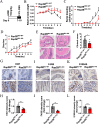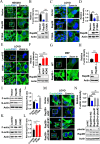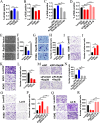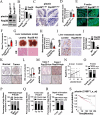Rap2B drives tumorigenesis and progression of colorectal cancer through intestinal cytoskeleton remodeling
- PMID: 40223002
- PMCID: PMC11994759
- DOI: 10.1038/s41419-025-07627-8
Rap2B drives tumorigenesis and progression of colorectal cancer through intestinal cytoskeleton remodeling
Abstract
Ras family protein plays a key role in transducing signals involved in cytoskeletal remodeling and cell adhesion, which are particularly important in the development of colorectal cancer (CRC). While Rap2B, a member of the Ras superfamily, has been linked to cancer malignancy in vitro, its exact role in tumorigenesis remains unclear. In this study, we demonstrated that intestine-specific knockout of Rap2B suppresses the initiation and progression of CRC. Mechanistically, Rap2B interacts with plectin and enhances its expression, which in turn inhibits plectin-mediated F-actin assembly. Deletion of Rap2B resulted in a remodeling of the intestinal cytoskeleton, leading to reduced tumorigenesis and diminished metastatic potential. Clinically, there is a positive correlation between the expression levels of Rap2B and plectin in human CRC tissues, and higher levels of Rap2B and plectin predicting poorer clinical outcome in CRC patients. These findings underscore a critical role of Rap2B in CRC progression and highlight its potential as a therapeutic target.
© 2025. The Author(s).
Conflict of interest statement
Competing interests: The authors declare no competing interests.
Figures








Similar articles
-
MicroRNA-147b Promotes Proliferation and Invasion of Human Colorectal Cancer by Targeting RAS Oncogene Family (RAP2B).Pathobiology. 2019;86(4):173-181. doi: 10.1159/000495253. Epub 2019 May 23. Pathobiology. 2019. PMID: 31121595
-
Inhibiting S-palmitoylation arrests metastasis by relocating Rap2b from plasma membrane in colorectal cancer.Cell Death Dis. 2024 Sep 14;15(9):675. doi: 10.1038/s41419-024-07061-2. Cell Death Dis. 2024. PMID: 39277583 Free PMC article.
-
Long non-coding RNA CCAT1 promotes non-small cell lung cancer progression by regulating the miR-216a-5p/RAP2B axis.Exp Biol Med (Maywood). 2021 Jan;246(2):142-152. doi: 10.1177/1535370220961013. Epub 2020 Oct 6. Exp Biol Med (Maywood). 2021. PMID: 33023331 Free PMC article.
-
Rap2B GTPase: structure, functions, and regulation.Tumour Biol. 2016 Jun;37(6):7085-93. doi: 10.1007/s13277-016-5033-y. Epub 2016 Mar 24. Tumour Biol. 2016. PMID: 27012552 Review.
-
Plectin: Dual Participation in Tumor Progression.Biomolecules. 2024 Aug 24;14(9):1050. doi: 10.3390/biom14091050. Biomolecules. 2024. PMID: 39334817 Free PMC article. Review.
References
MeSH terms
Substances
Grants and funding
LinkOut - more resources
Full Text Sources
Medical
Molecular Biology Databases

